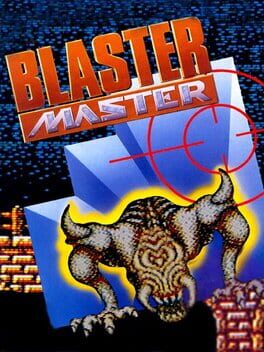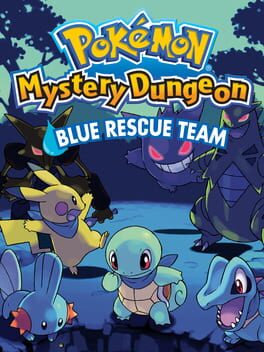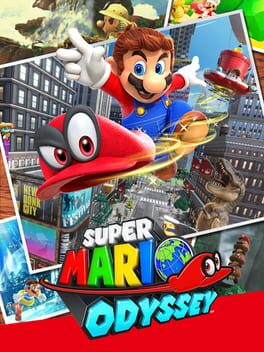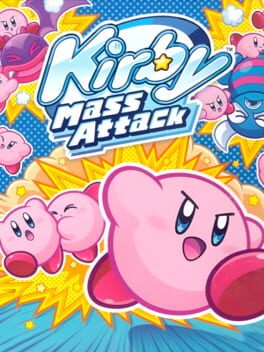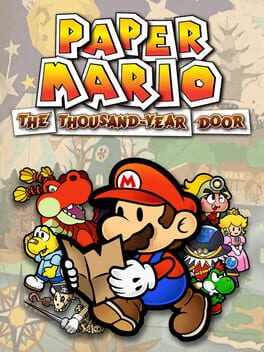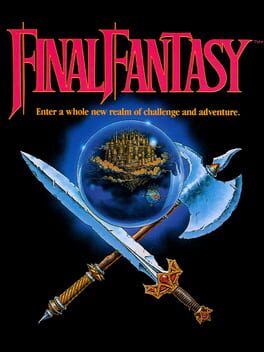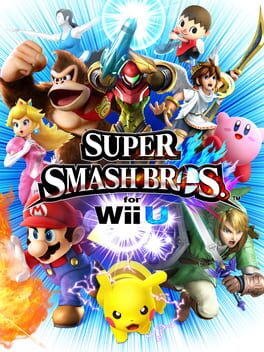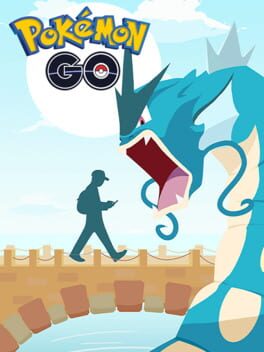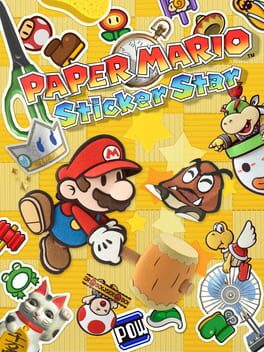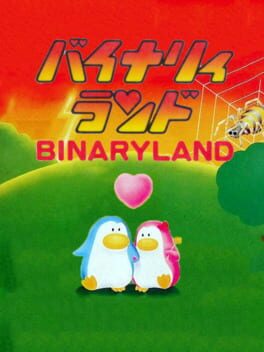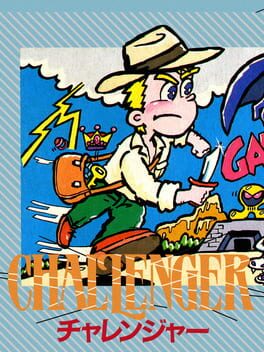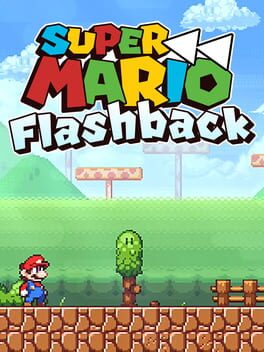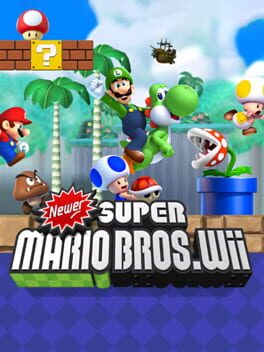mellorine
1988
I'm stuck on Area 3
It's like Metroid. Amazing music, nice atmosphere for NES standards, it's a technical marvel...
But the exploration platformer genre was simply not there yet in terms of its game design mentality branching out from the action platformer in the right ways, and in terms of its now laser-focused awareness on what quality of life features the genre needs, or at least benefits heavily from.
I want to play Blaster Master Zero one day, though. It looks like good fun!
It's like Metroid. Amazing music, nice atmosphere for NES standards, it's a technical marvel...
But the exploration platformer genre was simply not there yet in terms of its game design mentality branching out from the action platformer in the right ways, and in terms of its now laser-focused awareness on what quality of life features the genre needs, or at least benefits heavily from.
I want to play Blaster Master Zero one day, though. It looks like good fun!
What if like, Pokémon was... actually good?
What if they made use of species' traits directly within the storytelling, and what if they make it so that each Pokémon really is a clearly emoted character with its own characteristics based on its species - something that the main games just don't seem to have the capacity to do?
What if they actually made strategy, moveset management and team optimization an important aspect of single-player gameplay while getting rid of the awful aspects to raising Pokémon in the main games, like EVs/IVs?
What if they actually used the idea of endurance and attrition within dungeons as a legitimately well-thought out gameplay mechanic instead of being something you could just grind around by going in and out of the Pokémon Centers?
What if they actually got you to care about all the NPCs you met by making sure you know what they have to say at all times, instead of just the main cast being shoved into your face the whole time?
This is my preferred way to engage with the Pokémon franchise these days. It may not be perfect - I don't like not being able to evolve my starter, or not really being able to pick it, for that matter; the story is ultimately a little contrived to make up for the fact that gameplay gets a little stale unless there's plot development shoved into your face at every moment to give you a reason to keep playing; there are a few quirks about the gameplay in general that I think could be ironed out...
But this has so much going for it that it's actually willing to explore within the main, single player campaign - both in terms of how it handles the actual Pokémon, and in how complex it takes its gameplay by the end of it (and I haven't even started the postgame yet in this run!)
The music's good, the story's enjoyable if you don't think too much about it, it's fun to put more thought into battles (especially when you bring in an Escape Orb and get the option to bail and try again), the music's good...
I'm looking forward to completing the postgame and one day moving onto Explorers, probably Sky. It's a shame this series hasn't quite taken off after the first two.
(I think the main Pokémon games aren't bad; I really like Gen 4 and 5 as games, but I think the general Pokémon formula just isn't for me, and I feel like they've stayed a little too stagnant in their game design in all the wrong ways.)
What if they made use of species' traits directly within the storytelling, and what if they make it so that each Pokémon really is a clearly emoted character with its own characteristics based on its species - something that the main games just don't seem to have the capacity to do?
What if they actually made strategy, moveset management and team optimization an important aspect of single-player gameplay while getting rid of the awful aspects to raising Pokémon in the main games, like EVs/IVs?
What if they actually used the idea of endurance and attrition within dungeons as a legitimately well-thought out gameplay mechanic instead of being something you could just grind around by going in and out of the Pokémon Centers?
What if they actually got you to care about all the NPCs you met by making sure you know what they have to say at all times, instead of just the main cast being shoved into your face the whole time?
This is my preferred way to engage with the Pokémon franchise these days. It may not be perfect - I don't like not being able to evolve my starter, or not really being able to pick it, for that matter; the story is ultimately a little contrived to make up for the fact that gameplay gets a little stale unless there's plot development shoved into your face at every moment to give you a reason to keep playing; there are a few quirks about the gameplay in general that I think could be ironed out...
But this has so much going for it that it's actually willing to explore within the main, single player campaign - both in terms of how it handles the actual Pokémon, and in how complex it takes its gameplay by the end of it (and I haven't even started the postgame yet in this run!)
The music's good, the story's enjoyable if you don't think too much about it, it's fun to put more thought into battles (especially when you bring in an Escape Orb and get the option to bail and try again), the music's good...
I'm looking forward to completing the postgame and one day moving onto Explorers, probably Sky. It's a shame this series hasn't quite taken off after the first two.
(I think the main Pokémon games aren't bad; I really like Gen 4 and 5 as games, but I think the general Pokémon formula just isn't for me, and I feel like they've stayed a little too stagnant in their game design in all the wrong ways.)
1995
I feel like Chrono Trigger was what the previous nine years of JRPGs were building up to.
For a little bit of context, the week before I started Chrono Trigger, I had finally brought myself to complete Final Fantasy IV after months of putting the end on hold. Thinking about the JRPG genre and my relationship with it, I listed out some wants out of the genre as I continued to dive deeper into it.
Five days later, I started Chrono Trigger and found it satisfying basically everything I'd put on that list, and then some.
If Chrono Trigger was just another JRPG that happened to address my issues with the genre, I'd be very happy with it.
But the game has clearly gone far beyond being just a good game in the genre. Many others have put into words far better than I can about this game's triumphs and accomplishments, but I can say this much:
- Chrono Trigger makes me feel far more accomplished about figuring out a boss's strategy, and working around it to steamroll enemies I'd initially struggled against, than any other JRPG I've played so far.
- A few weeks into having finished Chrono Trigger, I find that it's still in the back of my mind, latched somewhere - and I think that's the testament of a very uniquely fascinating game, just as I'd spent countless hours reading and thinking about games like Undertale and Super Mario Odyssey.
It's not a perfect game - I wish Crono talked, and I think its battle system has room for slight adjustments and improvements. But if those are the two wishes I find myself walking out of this game...
I'm convinced the nine years of JRPGs before this game were worth that very moment.
For a little bit of context, the week before I started Chrono Trigger, I had finally brought myself to complete Final Fantasy IV after months of putting the end on hold. Thinking about the JRPG genre and my relationship with it, I listed out some wants out of the genre as I continued to dive deeper into it.
Five days later, I started Chrono Trigger and found it satisfying basically everything I'd put on that list, and then some.
If Chrono Trigger was just another JRPG that happened to address my issues with the genre, I'd be very happy with it.
But the game has clearly gone far beyond being just a good game in the genre. Many others have put into words far better than I can about this game's triumphs and accomplishments, but I can say this much:
- Chrono Trigger makes me feel far more accomplished about figuring out a boss's strategy, and working around it to steamroll enemies I'd initially struggled against, than any other JRPG I've played so far.
- A few weeks into having finished Chrono Trigger, I find that it's still in the back of my mind, latched somewhere - and I think that's the testament of a very uniquely fascinating game, just as I'd spent countless hours reading and thinking about games like Undertale and Super Mario Odyssey.
It's not a perfect game - I wish Crono talked, and I think its battle system has room for slight adjustments and improvements. But if those are the two wishes I find myself walking out of this game...
I'm convinced the nine years of JRPGs before this game were worth that very moment.
2017
Super Mario Odyssey is a big game with lots to love, with two tiny problems that ruin the game if you keep thinking about it for too long.
I should make it clear that my first time through was absolutely magical. I'd stayed almost entirely blind on it until my first playthrough in 2019, and many of the game's biggest twists (you're teased the Metro Kingdom before being thrown into the Lost Kingdom, only to find out the Mecha-Wiggler is invading New Donk; Bowser's Kingdom is Koji Kondo's love letter to traditional Japanese music with a surprising horn section blend; the entirety of the Underground Moon Caverns and endgame; the existence of the Mushroom Kingdom and the fact that you don't hop onto Yoshi like usual - you capture him) absolutely subverted my expectations in all the right ways, like Nintendo actively knew what I expected at every second and chose to twist it around every single time.
But I've 100%ed the game five times now. One of those playthroughs were marathoned in four days flat. Slowly, a game I'd considered on equal grounds as Super Mario 64, the video game of all time, one that's time and time again defined my entire relationship with video games... started to expose itself as the most fundamentally flawed Mario game.
Let's start with the controls. Mario's moveset is extremely, extremely streamlined in this game: jumping does almost half of all the actions, cap throwing does the other half, and diving and rolling are the extras that even the moveset out.
In doing so, there are two pretty obvious ideal traversal solutions that are almost never a bad idea. The standstill variation involves ground pound jumping, cap throwing, diving and cap bouncing; the longer variation involves rolling into Cappy and vaulting, then cap throwing, diving and cap bouncing.
There are almost no platforming solutions that cannot be solved with at least one of these two maneuvers, be it the Frog Skip, getting to the Forest Charging Station early, the Klepto Skip or even the Moon Skip.
This stands in stark contrast to Super Mario 64, where almost every jump has a distinct purpose of its own. You want to go for a long jump to skip Shocking Arrow Lifts; a wall kick into a jump dive to get onto Bob-omb Battlefield's floating island; a triple jump wall kick is the only thing that gives you enough height for Owlless, while a sideflip wall kick is what you want for Shoot Into the Wild Blue; even the twirl you get from a Spindrift can be what you need to bypass the cannon in Wall Kicks Will Work.
If Super Mario 64 at its best makes Mario feel like a versatile athlete with countless options and immediate reactions to any situation, Super Mario Odyssey eventually makes him feel like a fat guy with a magic hat - the magic hat itself is extremely fun, but almost in spite of the fat guy. Perhaps that's the reason Cappy-less side areas are left to a minimum.
This is further compounded by the Captures themselves being some of the most one-dimensional movement ever seen in Super Mario. Sure, Pokio could make for an amazing, if compact game all on its own, but the only other enemies offering anything resembling interesting movement are the Yoshi, Gushen, Lava Bubble, Tropical Wiggler and Uproot, in that order: all of which are heavily underutilized. The rest of the captures are one trick ponies, used to solve a predictable puzzle, (a horde of Goombas? You better stack them to reach something high up!) or minigames, like the Bound Bowl or RC Car.
Compare this to the Wing Cap, the various FLUDD nozzles, even the Galaxy powerups, and... this was honestly a letdown in all but concept.
I don't have a transition into the Second Big Flaw. Super Mario Odyssey touts itself as the third game in the hakoniwa (walled garden)-style of 3D Mario games, following Super Mario 64 and Super Mario Sunshine. Yet it comes immediately after ten years of course clear-styled 3D Mario, spanning four games between Super Mario Galaxy and Super Mario 3D World. Nintendo did not want to alienate these people, so what did they do?
They compromised.
Super Mario Odyssey may follow 64 and Sunshine's sense of scale when it comes to big, intraconnected environments, but the rest of it follows a course clear mentality, just shuffled in different ways. Not only are the main story quests - which are necessary to complete in order to unlock a majority of the game's Power Moons - all linear romps, (Wooded and Bowser's Kingdoms are the most egregious about this; at least kingdoms like Lake or Nighttime Metro offer the player the ability to decide how to get to the destination) necessitating that at least half the Kingdoms are designed to match; all the side areas are often just as linear, mostly being akin to small self-contained levels that at their best offer an interesting spin on a capture... but at their worst feel like rejects from 3D Land and 3D World.
But even in the bigger picture, the game progression is also quite linear, each Kingdom acting as a sort of macro-course to complete to whatever capacity the player desires before moving on. Super Mario 64, Sunshine and even Galaxy didn't do this: they all offered the player the ability to choose the order they would play courses to some greater extent than Odyssey's two instances of split paths that both eventually converge. Sure, you could always go back to previous kingdoms to hunt for Moons before you're done with the main game if you want, but what's the point? It doesn't give you the option to skip Kingdoms, or even unlock anything meaningful before the postgame.
Super Mario Odyssey's biggest flaw in its game progression is that most of its Power Moons have zero value during the main game, especially since the story objectives put players extremely close to meeting each Kingdom's quota (seven of Bowser's Kingdom's mandatory ten Moons can be obtained from the linear story quest; four of Cascade's five from the Madam Broode fight and the mandatory first Power Moon) - they have almost zero impact to the progression of the game, compared to other games like Super Mario 64, or even Banjo-Kazooie or even, humiliatingly enough, 3D World.
Finally, the lack of a hub world like Super Mario 64, Sunshine or even Galaxy 2 (yes, I'm a big fan of Starship Mario) mandates Odyssey to provide players with a sense of security elsewhere... and Odyssey responded in quite possibly the most baffling decision I've ever seen from the Super Mario series:
The Kingdoms themselves are the hub worlds.
Think about it. Metro Kingdom is the most obvious example, having literally zero harmful obstacles in Daytime aside from bottomless pits; but other kingdoms apply this sense of design as well. The Cloud and Ruined Kingdoms are literally only used as gateways into other side areas, as is the Dark Side of the Moon; almost all of the Power Moons provided from breaking the Moon Rocks come in the form of Moon Pipes, accessed from within the kingdoms themselves but set in the same linear sub-levels as other warp pipes and doors.
In order to compensate, the Kingdoms remain fairly basic in navigational complexity - the linear design in most of them being a boon in this specific instance since players can just make their way across Kingdoms and chance upon the Moon Pipes as they go.
But in doing so, Super Mario Odyssey trades away so much of its capacity for demanding, interesting, challenging moment-to-moment platforming - not that the Checkpoint system wouldn't have trivialized it anyway.
(EDIT: I wanted to include my thoughts on Super Mario Odyssey's approach to 100% completion:
"I think Odyssey has an internal conflict about the idea of 100% completion. As a companion game to Breath of the Wild, which made a point to de-emphasize 100% completion and prompted players to find their own satisfaction and enjoyment, Odyssey seems to offer the players the option to choose where their ending, their completion is.
But it falls flat on its face when you consider that BotW worked in that regard because it never gave you a list of how many shrines or Koroks there were - the sheer fact that pressing Minus gives you a list of how many Moons are present in each Kingdom, collecting Purple Coins shows you a counter of how many you have left to find, going into the shop post-game shows how many Moons you need to unlock more costumes, the Odyssey itself telling you how many more to unlock the Dark and Darker Sides of the Moon... it's all so counter-intuitive and almost two-faced.")
I want to make it clear that I don't think Super Mario Odyssey is by any means a bad game. It's not as fundamentally flawed as many other platformers I've seen and played; it's not even as tonally confused as something like Super Mario Galaxy was.
Super Mario Odyssey has provided me with some of my favorite moments in video games, at a time where I needed something like it, something to make some very bad situations better. Its best musical moments are some of my favorites from the series, even if Break Free (Lead the Way) makes me cringe about the time I brought it to my college band to play - I must have done so because I loved it at the time I decided to do that.
Snapshot Mode, alongside the various outfits, is easily the best understated innovation in the Super Mario series, and Luigi's Balloon World is the actual best post-game found in any Super Mario game ever - but these amazing features live to keep the game afloat, when it could have been the cherry on the cake on another, really focused Super Mario game.
But this might be the first generation in a long time where Super Mario floundered due to being built on a weak foundation, whilst Zelda triumphed in its cohesive, holistic sense of design - the first generation where I can easily say the Zelda of its time was stronger than the Mario of its time.
It's... it's just a little misdirected. It's stuck in the middle of two mentalities to Super Mario that didn't quite know how to commit, in an almost mirror image of Super Mario Galaxy's fatal flaw. It doesn't land quite as well as any of the games that committed, for better or for worse (my list would include 64, Sunshine, 3D Land and 3D World), but I want to see Nintendo commit. I've heard Bowser's Fury might be getting close. I'll look forward to it... one day.
Oh, but why did I give this game a 5/5 if I have so many issues with it?
https://media.discordapp.net/attachments/624717617999118349/829867114080501780/unknown.png
I should make it clear that my first time through was absolutely magical. I'd stayed almost entirely blind on it until my first playthrough in 2019, and many of the game's biggest twists (you're teased the Metro Kingdom before being thrown into the Lost Kingdom, only to find out the Mecha-Wiggler is invading New Donk; Bowser's Kingdom is Koji Kondo's love letter to traditional Japanese music with a surprising horn section blend; the entirety of the Underground Moon Caverns and endgame; the existence of the Mushroom Kingdom and the fact that you don't hop onto Yoshi like usual - you capture him) absolutely subverted my expectations in all the right ways, like Nintendo actively knew what I expected at every second and chose to twist it around every single time.
But I've 100%ed the game five times now. One of those playthroughs were marathoned in four days flat. Slowly, a game I'd considered on equal grounds as Super Mario 64, the video game of all time, one that's time and time again defined my entire relationship with video games... started to expose itself as the most fundamentally flawed Mario game.
Let's start with the controls. Mario's moveset is extremely, extremely streamlined in this game: jumping does almost half of all the actions, cap throwing does the other half, and diving and rolling are the extras that even the moveset out.
In doing so, there are two pretty obvious ideal traversal solutions that are almost never a bad idea. The standstill variation involves ground pound jumping, cap throwing, diving and cap bouncing; the longer variation involves rolling into Cappy and vaulting, then cap throwing, diving and cap bouncing.
There are almost no platforming solutions that cannot be solved with at least one of these two maneuvers, be it the Frog Skip, getting to the Forest Charging Station early, the Klepto Skip or even the Moon Skip.
This stands in stark contrast to Super Mario 64, where almost every jump has a distinct purpose of its own. You want to go for a long jump to skip Shocking Arrow Lifts; a wall kick into a jump dive to get onto Bob-omb Battlefield's floating island; a triple jump wall kick is the only thing that gives you enough height for Owlless, while a sideflip wall kick is what you want for Shoot Into the Wild Blue; even the twirl you get from a Spindrift can be what you need to bypass the cannon in Wall Kicks Will Work.
If Super Mario 64 at its best makes Mario feel like a versatile athlete with countless options and immediate reactions to any situation, Super Mario Odyssey eventually makes him feel like a fat guy with a magic hat - the magic hat itself is extremely fun, but almost in spite of the fat guy. Perhaps that's the reason Cappy-less side areas are left to a minimum.
This is further compounded by the Captures themselves being some of the most one-dimensional movement ever seen in Super Mario. Sure, Pokio could make for an amazing, if compact game all on its own, but the only other enemies offering anything resembling interesting movement are the Yoshi, Gushen, Lava Bubble, Tropical Wiggler and Uproot, in that order: all of which are heavily underutilized. The rest of the captures are one trick ponies, used to solve a predictable puzzle, (a horde of Goombas? You better stack them to reach something high up!) or minigames, like the Bound Bowl or RC Car.
Compare this to the Wing Cap, the various FLUDD nozzles, even the Galaxy powerups, and... this was honestly a letdown in all but concept.
I don't have a transition into the Second Big Flaw. Super Mario Odyssey touts itself as the third game in the hakoniwa (walled garden)-style of 3D Mario games, following Super Mario 64 and Super Mario Sunshine. Yet it comes immediately after ten years of course clear-styled 3D Mario, spanning four games between Super Mario Galaxy and Super Mario 3D World. Nintendo did not want to alienate these people, so what did they do?
They compromised.
Super Mario Odyssey may follow 64 and Sunshine's sense of scale when it comes to big, intraconnected environments, but the rest of it follows a course clear mentality, just shuffled in different ways. Not only are the main story quests - which are necessary to complete in order to unlock a majority of the game's Power Moons - all linear romps, (Wooded and Bowser's Kingdoms are the most egregious about this; at least kingdoms like Lake or Nighttime Metro offer the player the ability to decide how to get to the destination) necessitating that at least half the Kingdoms are designed to match; all the side areas are often just as linear, mostly being akin to small self-contained levels that at their best offer an interesting spin on a capture... but at their worst feel like rejects from 3D Land and 3D World.
But even in the bigger picture, the game progression is also quite linear, each Kingdom acting as a sort of macro-course to complete to whatever capacity the player desires before moving on. Super Mario 64, Sunshine and even Galaxy didn't do this: they all offered the player the ability to choose the order they would play courses to some greater extent than Odyssey's two instances of split paths that both eventually converge. Sure, you could always go back to previous kingdoms to hunt for Moons before you're done with the main game if you want, but what's the point? It doesn't give you the option to skip Kingdoms, or even unlock anything meaningful before the postgame.
Super Mario Odyssey's biggest flaw in its game progression is that most of its Power Moons have zero value during the main game, especially since the story objectives put players extremely close to meeting each Kingdom's quota (seven of Bowser's Kingdom's mandatory ten Moons can be obtained from the linear story quest; four of Cascade's five from the Madam Broode fight and the mandatory first Power Moon) - they have almost zero impact to the progression of the game, compared to other games like Super Mario 64, or even Banjo-Kazooie or even, humiliatingly enough, 3D World.
Finally, the lack of a hub world like Super Mario 64, Sunshine or even Galaxy 2 (yes, I'm a big fan of Starship Mario) mandates Odyssey to provide players with a sense of security elsewhere... and Odyssey responded in quite possibly the most baffling decision I've ever seen from the Super Mario series:
The Kingdoms themselves are the hub worlds.
Think about it. Metro Kingdom is the most obvious example, having literally zero harmful obstacles in Daytime aside from bottomless pits; but other kingdoms apply this sense of design as well. The Cloud and Ruined Kingdoms are literally only used as gateways into other side areas, as is the Dark Side of the Moon; almost all of the Power Moons provided from breaking the Moon Rocks come in the form of Moon Pipes, accessed from within the kingdoms themselves but set in the same linear sub-levels as other warp pipes and doors.
In order to compensate, the Kingdoms remain fairly basic in navigational complexity - the linear design in most of them being a boon in this specific instance since players can just make their way across Kingdoms and chance upon the Moon Pipes as they go.
But in doing so, Super Mario Odyssey trades away so much of its capacity for demanding, interesting, challenging moment-to-moment platforming - not that the Checkpoint system wouldn't have trivialized it anyway.
(EDIT: I wanted to include my thoughts on Super Mario Odyssey's approach to 100% completion:
"I think Odyssey has an internal conflict about the idea of 100% completion. As a companion game to Breath of the Wild, which made a point to de-emphasize 100% completion and prompted players to find their own satisfaction and enjoyment, Odyssey seems to offer the players the option to choose where their ending, their completion is.
But it falls flat on its face when you consider that BotW worked in that regard because it never gave you a list of how many shrines or Koroks there were - the sheer fact that pressing Minus gives you a list of how many Moons are present in each Kingdom, collecting Purple Coins shows you a counter of how many you have left to find, going into the shop post-game shows how many Moons you need to unlock more costumes, the Odyssey itself telling you how many more to unlock the Dark and Darker Sides of the Moon... it's all so counter-intuitive and almost two-faced.")
I want to make it clear that I don't think Super Mario Odyssey is by any means a bad game. It's not as fundamentally flawed as many other platformers I've seen and played; it's not even as tonally confused as something like Super Mario Galaxy was.
Super Mario Odyssey has provided me with some of my favorite moments in video games, at a time where I needed something like it, something to make some very bad situations better. Its best musical moments are some of my favorites from the series, even if Break Free (Lead the Way) makes me cringe about the time I brought it to my college band to play - I must have done so because I loved it at the time I decided to do that.
Snapshot Mode, alongside the various outfits, is easily the best understated innovation in the Super Mario series, and Luigi's Balloon World is the actual best post-game found in any Super Mario game ever - but these amazing features live to keep the game afloat, when it could have been the cherry on the cake on another, really focused Super Mario game.
But this might be the first generation in a long time where Super Mario floundered due to being built on a weak foundation, whilst Zelda triumphed in its cohesive, holistic sense of design - the first generation where I can easily say the Zelda of its time was stronger than the Mario of its time.
It's... it's just a little misdirected. It's stuck in the middle of two mentalities to Super Mario that didn't quite know how to commit, in an almost mirror image of Super Mario Galaxy's fatal flaw. It doesn't land quite as well as any of the games that committed, for better or for worse (my list would include 64, Sunshine, 3D Land and 3D World), but I want to see Nintendo commit. I've heard Bowser's Fury might be getting close. I'll look forward to it... one day.
Oh, but why did I give this game a 5/5 if I have so many issues with it?
https://media.discordapp.net/attachments/624717617999118349/829867114080501780/unknown.png
2011
came for the main game, stayed for the masterpieces that are kirby quest, kirby's brawlball and strato patrol eos
kirby subgames have never hit this hard... except maybe drum dash.
i'd love to return to it now that i've played the pikmin games to see how i feel about the main game, but i don't have a ds at the moment.
kirby subgames have never hit this hard... except maybe drum dash.
i'd love to return to it now that i've played the pikmin games to see how i feel about the main game, but i don't have a ds at the moment.
I dunno, I just don't get it.
Does having an interesting combat system in theory mean that a game has interesting gameplay? Pokémon has an extremely fascinating combat system, but it makes awful use of it.
Does having some undeniably charming moments mean that a game has good story? Lots of games have those things, but fall flat on their storytelling.
Does being visually interesting mean that a virtual world feels lived in? Heh, just look at Hover.
I think Paper Mario 1 worked with its basic locales because they played to the strengths of what the franchise had already established. Goombas and Koopas having peaceful establishments was an interesting twist, it makes sense that a series focused around Stars (Star World, Power Stars, Starmen, Star Road... all that before Super Mario Galaxy) would have Star Spirits as deities, Bowser's immature personality implied through Super Mario Bros. 3 and Super Mario 64 was elaborated upon, making him a really likeable villain...
Thousand-Year Door throws that all out of the window in a certain overconfidence that its own storytelling is going to stand just as strong, but it just... doesn't land right?
I won't pretend I didn't like Vivian, but "I like this one character" is not a real reason for GOTY (game of thousand years) status.
Does having an interesting combat system in theory mean that a game has interesting gameplay? Pokémon has an extremely fascinating combat system, but it makes awful use of it.
Does having some undeniably charming moments mean that a game has good story? Lots of games have those things, but fall flat on their storytelling.
Does being visually interesting mean that a virtual world feels lived in? Heh, just look at Hover.
I think Paper Mario 1 worked with its basic locales because they played to the strengths of what the franchise had already established. Goombas and Koopas having peaceful establishments was an interesting twist, it makes sense that a series focused around Stars (Star World, Power Stars, Starmen, Star Road... all that before Super Mario Galaxy) would have Star Spirits as deities, Bowser's immature personality implied through Super Mario Bros. 3 and Super Mario 64 was elaborated upon, making him a really likeable villain...
Thousand-Year Door throws that all out of the window in a certain overconfidence that its own storytelling is going to stand just as strong, but it just... doesn't land right?
I won't pretend I didn't like Vivian, but "I like this one character" is not a real reason for GOTY (game of thousand years) status.
1987
This game and Dragon Quest 1 being my first introductions to JRPGs that weren't Mario or Pokémon might have ruined my impressions about the entire genre for the longest time.
I've played this on both the PSP and the NES versions, and neither of them are really satisfactory. The whole adventure feels pointless when there's a plot, but virtually zero storytelling; given how stat buffs and statuses are so unexplained (did trying to cast a Slow spell on the enemy even work? does Blind even do anything?), I feel like magic just devolves into spamming elemental attacks and healing, especially in the NES version where spell charges are so much more limited, and I'm starting to realize I really don't like it when RPGs are just about beating each other up indiscriminately until one side dies.
I'd say I respect the targeting system in the original, but I feel like it was a start of a decent idea that the genre and game design just wasn't ready for at the time. In getting rid of it, I think the PSP version also gets rid of the only interesting thing about Final Fantasy 1, and, that's a shame.
Also, tiles that always trigger boss encounters EVERY TIME you step on them? Who thought that was a good idea?
I've played this on both the PSP and the NES versions, and neither of them are really satisfactory. The whole adventure feels pointless when there's a plot, but virtually zero storytelling; given how stat buffs and statuses are so unexplained (did trying to cast a Slow spell on the enemy even work? does Blind even do anything?), I feel like magic just devolves into spamming elemental attacks and healing, especially in the NES version where spell charges are so much more limited, and I'm starting to realize I really don't like it when RPGs are just about beating each other up indiscriminately until one side dies.
I'd say I respect the targeting system in the original, but I feel like it was a start of a decent idea that the genre and game design just wasn't ready for at the time. In getting rid of it, I think the PSP version also gets rid of the only interesting thing about Final Fantasy 1, and, that's a shame.
Also, tiles that always trigger boss encounters EVERY TIME you step on them? Who thought that was a good idea?
2016
Wow, this is one of the best jazz Mario cover albums ever! From Super Mario Galaxy's Boo Waltz, a 6/4 version of Airship, to Slider of all things? The original songs are all good too!
I really love how the Starman theme is totally reimagined here - it's like how Sonic final boss themes tend to have a Phase 2 representing Sonic's strength, usually in Super Sonic form. I could go on and on about all the songs I really love from this album. I wonder who the remixers were?
...wait, what? this is a soundtrack to a game? what game?
I really love how the Starman theme is totally reimagined here - it's like how Sonic final boss themes tend to have a Phase 2 representing Sonic's strength, usually in Super Sonic form. I could go on and on about all the songs I really love from this album. I wonder who the remixers were?
...wait, what? this is a soundtrack to a game? what game?
1984
1985
Its best moments can make for some actually intense, precise platforming, but overall it's just too inconsistent in its level design and its construction to be worthy of a serious recommendation.
At the end of the day, I think NSMBWii was a very flawed foundation to work off of, and while Newer tries its best to make something a bit more thoughtful out of its template, it just feels like Mario Maker-tier level design too often, unfortunately.
It's a technical marvel, but as a certain washed-up YouTuber says:
"So is the cotton gym, but I wouldn't take it with me on the car!"
EDIT 09:08/2021: holy hell if this game doesn't have too much content for its own good. i would have rather seen half the number of levels with double the polish
At the end of the day, I think NSMBWii was a very flawed foundation to work off of, and while Newer tries its best to make something a bit more thoughtful out of its template, it just feels like Mario Maker-tier level design too often, unfortunately.
It's a technical marvel, but as a certain washed-up YouTuber says:
"So is the cotton gym, but I wouldn't take it with me on the car!"
EDIT 09:08/2021: holy hell if this game doesn't have too much content for its own good. i would have rather seen half the number of levels with double the polish
1989
Maybe "A Mario game you can casually play while you watch something else" might not have been such a good sell in 1989, but it's so perfectly cozy now.
The fact that you can be over with the game in about a half hour makes it great to go back to every couple of months to burn some time while you listen to a podcast or something.
The fact that you can be over with the game in about a half hour makes it great to go back to every couple of months to burn some time while you listen to a podcast or something.
